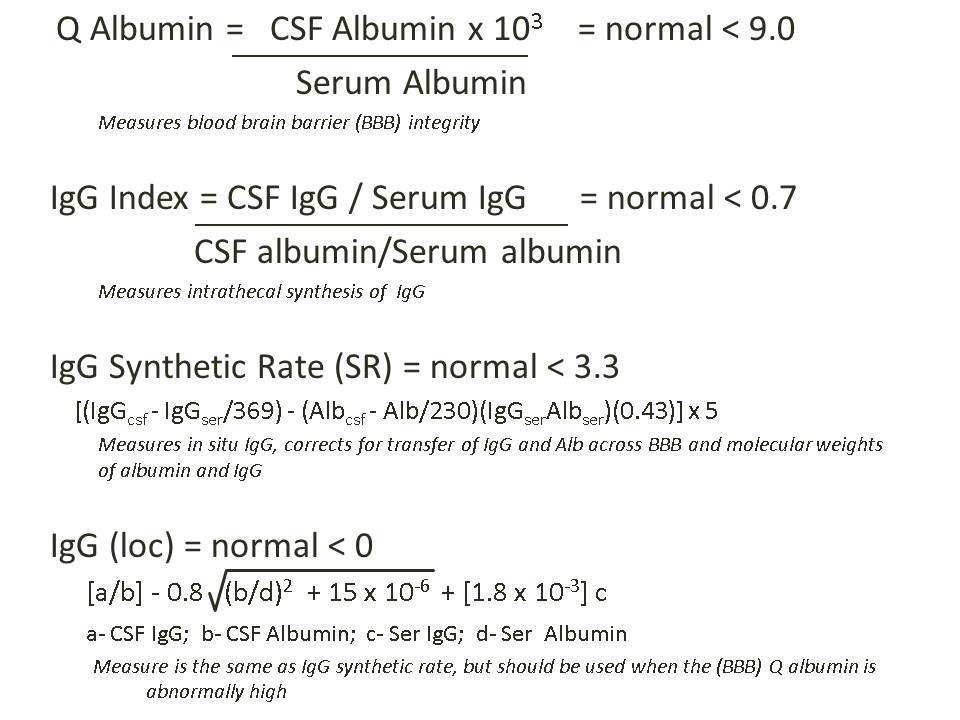Cerebrospinal Fluid Studies
Last updated: November 25, 2014
Description: Cerebrospinal fluid (CSF) tests may be used in diagnosing or distinguishing between benign, infectious, autoimmune, inflammatory, hemorrhagic, obstructive and neoplastic disorders of the central nervous system (CNS).
Method: The clinician should look for signs of increased intracranial pressure (i.e., papilledema) or perform cranial imaging [computed tomography or magnetic resonance imaging (MRI)] before doing lumbar puncture. CSF should be aseptically obtained, with the opening pressure and appearance of fluid recorded. Routine CSF studies include cell and differential counts, glucose and protein determinations and serologic tests for syphilis. When infection is considered, microbiologic assays may include Gram staining; culture for bacteria, fungi or mycobacteria; or detection of microbial antigens (e.g., cryptococcal, pneumococcal, meningococcal, or Haemophilus influenzae) by latex agglutination. Other serologic tests may be done to diagnosis infections such as syphilis, West Nile virus, parasites (e.g. ) or helminthic (e.g., cysticercosis). With suspected inflammatory or autoimmune causes, it may be useful to test for CSF oligoclonal bands or quantitate intrathecal immunologic activity by measuring in situ CSF immunoglobulin (IgG or IgM) synthesis and CSF to serum albumin quotient (called the Q albumin) to ascertain the intactness of the blood-brain barrier.
—Q albumin: Estimates the state of the blood-brain barrier (BBB) integrity (or the rate of albumin transfer between compartments); requires a paired sample of serum and CSF for analysis.
—IgG index: Calculates the amount of in situ IgG production within the CSF (intrathecal synthesis of IgG); requires a paired sample of serum and CSF for analysis; tends to be increased in a variety of conditions including multiple sclerosis, neuropsychiatric lupus, and neurosyphilis.
—IgG synthetic rate or IgGloc: Another measure of in situ IgG production is the IgG synthetic rate. IgG synthetic rate measures in situ IgG, corrects for transfer of IgG and albumin across BBB and considers the molecular weight of albumin and IgG. Many advocate this calculation as the more reliable indicator of IgG synthesis. However, when there is a breakdown in BBB permeability (if the Q albumin is >9.0) then the correct measure is the IgGloc.
—Oligoclonal bands: Indicate the presence of clonally restricted immunoglobulins identified by high-resolution electrophoresis or isoelectric focusing. Test requires a paired sample of serum and CSF for analysis. Oligoclonal bands are seen in nearly 90% of patients with multiple sclerosis. They are also found in a minority of patients with SLE, neuro-Behçet’s syndrome, neurosyphilis, cerebral vasculitis, Guillain-Barré syndrome, and encephalitis.
Normal Values: CSF is normally clear, colorless, and without cells. Blood or RBCs may indicate a traumatic tap or subarachnoid or intracerebral hemorrhage. Xanthochromia indicates hemorrhage.
Abnormal in: Tests should be used selectively to establish/confirm clinical suspicions. Ordering all CSF tests is likely to be expensive and provide misleading rather than diagnostic information.
| Table: CSF Findings in Selected Neurologic Conditions | ||||||||
| Disorder | Opening Pressure (mm Hg) | WBC (cells/mm3) | Cell Type | CSF Glucose | CSF Protein (mg/dL) | IgG Index | Q albumin | Oligoclonal Bands (% Positive) |
|---|---|---|---|---|---|---|---|---|
| Normal results* | 60-180 | 0-5 | Lymphocytes, monocytes | >60% of serum value | 15-45 | < 0.7 | <9.0 | Negative |
| Bacterial meningitis | High | 100-10,000 | Neutrophils | Low or normal | 100-500 | < 0.7 | >15.0 | Negative |
| Cryptococcal or tuberculous meningitis | High | 50-500 | Lymphocytes | Low or normal | 100-500 | Normal or high | 15-100 | Negative |
| Neuropsychiatric Lupus (cerebritis) | Normal or high | 0-50 | Lymphocytes | Normal or low | Normal | 65% are > 0.7 |
67% <9.0 33% 9-15 |
0-40% |
| Multiple sclerosis | Normal | 0-20 | Lymphocytes | Normal | Normal | 80% > 0.7 | 75% <9.0 | >90% |
| Neuro-Behçet syndrome | Normal | > 100 | Lymphocytes, monocytes | Normal | Increased | 20-50% > 0.7 | 40% >9.0 | < 10% |
| Neurosarcoid | Normal or high | 100-500 | Lymphocytes, monocytes | Normal or low | 40-100 | 20-80% > 0.7 | 12%-80% >9.0 | 0-50% |
| Neurosyphilis | Normal or high | < 100 | Lymphocytes, monocytes | Normal or low | 40-200 | ↑ in 80% | ↑ in 80% | 50% |
| * Normal reference values may vary according to laboratory. CSF, cerebrospinal fluid; WBC, white blood cell. | ||||||||
Confounding Factors: A traumatic tap alters the reliability of cell counts, glucose and protein determinations, IgG index, and Q albumin.
Indications: In patients with suspected meningitis, encephalitis, subarachnoid or intracerebral hemorrhage, neurosyphilis, multiple sclerosis, neuropsychiatric lupus, primary CNS vasculitis, or inflammatory conditions with suspected CNS involvement (i.e., Behçet syndrome, sarcoidosis).
Cost: Cell count, $20–30; CSF protein, $30–50; IgG index, $130–190; antineuronal antibody, $180.
BIBLIOGRAPHY
Andersson M, Alvarez-Cermeno J, Bernardi G, et al. Cerebrospinal fluid in the diagnosis of multiple sclerosis: a consensus report. J Neurol Neurosurg Psychiatry 1994;57:897–902.PMID: 8057110
Hanly JG. Diagnosis and management of neuropsychiatric SLE. Nat Rev Rheumatol. 2014;10:338-47. PMID: 24514913



